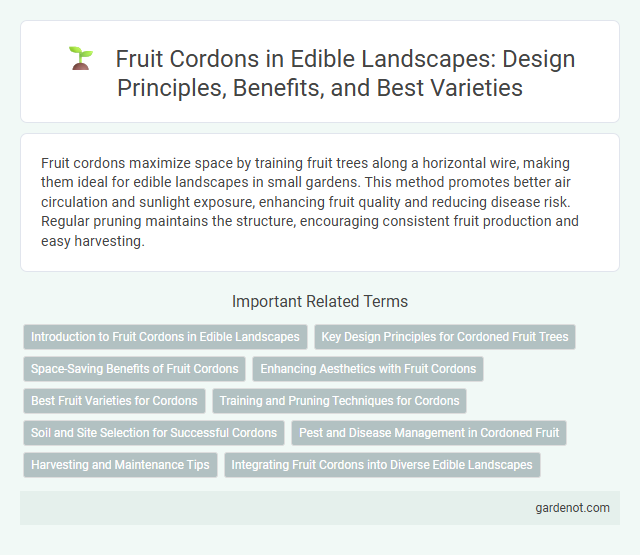Fruit cordons maximize space by training fruit trees along a horizontal wire, making them ideal for edible landscapes in small gardens. This method promotes better air circulation and sunlight exposure, enhancing fruit quality and reducing disease risk. Regular pruning maintains the structure, encouraging consistent fruit production and easy harvesting.
Introduction to Fruit Cordons in Edible Landscapes
Fruit cordons represent a specialized pruning and training technique designed to cultivate fruiting plants along a single main stem, usually trained horizontally against walls or trellises in edible landscapes. This method maximizes space efficiency while enhancing sunlight exposure, promoting higher yields of fruit such as apples, pears, or quinces in compact garden settings. Fruit cordons contribute to sustainable gardening practices by enabling easy maintenance, pest management, and an aesthetically pleasing integration of productive plants within outdoor living areas.
Key Design Principles for Cordoned Fruit Trees
Key design principles for cordoned fruit trees include selecting dwarf or semi-dwarf rootstocks to ensure manageable tree size and promoting better fruit production. Training the main stem vertically with evenly spaced lateral branches at 30-45 degree angles enhances sunlight exposure and air circulation, reducing disease risk. Consistent pruning to remove unwanted shoots and maintain the structure supports healthy growth and optimizes fruit yield in edible landscapes.
Space-Saving Benefits of Fruit Cordons
Fruit cordons maximize garden productivity by training fruit trees or vines along narrow supports, ideal for limited spaces such as small urban yards or balconies. This vertical growth method enhances air circulation and sunlight exposure, promoting healthier plants and higher yields in compact areas. Efficient use of vertical space reduces ground footprint, allowing gardeners to cultivate diverse edible plants without overcrowding.
Enhancing Aesthetics with Fruit Cordons
Fruit cordons create visually striking edible landscapes by training fruit trees into elegant, linear forms against walls or fences. This technique maximizes space efficiency while showcasing vibrant blossoms and ripening fruits, adding seasonal color and texture. Incorporating fruit cordons enhances garden aesthetics by blending practicality with ornamental beauty.
Best Fruit Varieties for Cordons
The best fruit varieties for cordons include apples, peaches, and pears due to their natural ability to thrive with limited space and their high fruit yield on trained branches. Dwarf and semi-dwarf rootstocks enhance cordon productivity by controlling growth while promoting fruit development. Choosing disease-resistant cultivars such as 'Red Delicious' apples or 'Victoria' peaches ensures healthier plants and more consistent harvests in edible landscapes.
Training and Pruning Techniques for Cordons
Training and pruning techniques for fruit cordons involve carefully guiding young shoots along a horizontal wire or trellis to encourage strong, fruit-bearing spurs. Regular summer pruning removes vigorous, non-fruiting shoots, while winter pruning focuses on cutting back to healthy buds, ensuring optimal air circulation and light penetration. This management enhances fruit quality and yield by maintaining a balanced structure and preventing overcrowding.
Soil and Site Selection for Successful Cordons
Healthy fruit cordons thrive in well-drained, fertile soil rich in organic matter and with a pH between 6.0 and 7.0. Site selection should prioritize full sun exposure and protection from strong winds to enhance fruit production and prevent damage. Proper soil preparation, including loosening and amending with compost, ensures optimal root development and improved nutrient uptake.
Pest and Disease Management in Cordoned Fruit
Effective pest and disease management in cordoned fruit involves regular monitoring for common issues such as aphids, scale insects, and fungal diseases like powdery mildew and rust. Implementing integrated pest management (IPM) techniques, including organic sprays, horticultural oils, and beneficial insect introductions, helps maintain plant health without harmful chemicals. Proper pruning and sanitation reduce disease incidence by improving air circulation and removing infected material.
Harvesting and Maintenance Tips
Fruit cordons require regular pruning during the dormant season to maintain their shape and promote healthy fruit production. Harvest fruits when they are fully ripe, typically in late summer to early autumn, to ensure optimal flavor and sweetness. Consistent watering and mulching help preserve soil moisture and reduce weed growth, enhancing overall plant health.
Integrating Fruit Cordons into Diverse Edible Landscapes
Fruit cordons offer a space-efficient solution for incorporating productive fruit-bearing plants into diverse edible landscapes, maximizing yield on limited ground area. These trained, single-stemmed fruit trees can be seamlessly integrated into fences, walls, and garden borders, providing both aesthetic appeal and functional harvests. Their adaptability allows gardeners to create layered planting schemes that combine fruits with herbs and vegetables, enhancing biodiversity and sustainable food production.
Fruit cordon Infographic

 gardenot.com
gardenot.com